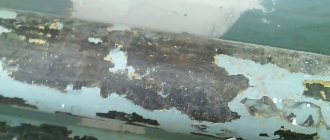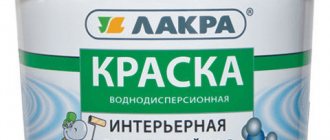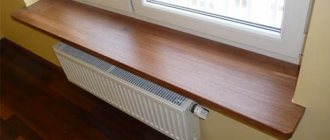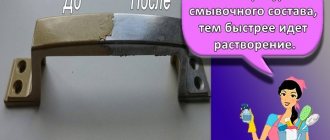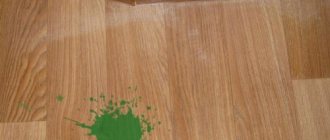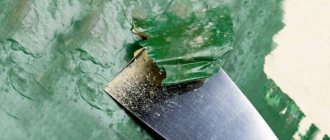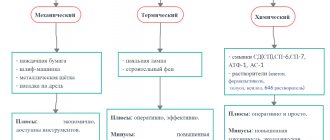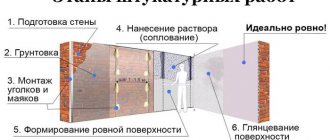In Soviet-built houses, the walls of bathrooms, kitchens and toilets are decorated with paints and varnishes. It can be difficult to remove them when renovating premises.
A variety of methods can be used to remove paint from concrete walls.
The choice of a specific option for removing paint and varnish composition also depends on the type of paint that was used to treat the walls. We'll tell you how to remove paint from concrete walls in this article.
Paint on a concrete wall: when should it be removed?
It is necessary to remove old paint if you have to apply building mixtures directly to the walls, for example:
- When leveling the surface with plaster, mouth with plaster, etc.
- If you plan to cover the wall with tiles or decorative panels.
- Before puttying.
- In some cases, it is necessary to remove the old paint before repainting so that it does not bleed through over time. This is especially true for different shades of red, which are very difficult to cover up with another color.
- Also, removal must be carried out before wallpapering.
It is necessary to remove the old coating so that after drying the building mixtures do not peel off from the wall. Some types of paints undergo chemical reactions, which can lead to stains and cracks.
If you plan to decorate the room with panels that are attached using bars, guides or plasterboard, then it is not necessary to clean the walls before installing them.
Getting rid of the water-based coating
There is one exception to the above rule: if the surface has been additionally treated with a protective agent, it will not be possible to clean it with water alone. Special formulations will help to cope with this.
You can also clean the water-based coating by heating it with a hair dryer. The coating softened by hot air is removed from the surface. If the area is large enough, the procedure will take a lot of time and effort.
Kawabanga! Important aspects of painting a concrete fence with your own hands
How can you remove old paint from a concrete wall?
There are many ways to remove paintwork, which can be divided into three main groups:
- 1) mechanical method, consisting of simple scraping or erasing with a spatula, steel brush or using a drill with a special attachment;
- 2) thermal, which is the softening of old layers by heating;
- 3) chemical - washing off paint from the surface with solvents.
Spatula and hatchet or steel bristle brush
The mechanical method is the simplest and does not require special material costs for the purchase of additional tools or solvents.
Advantages of the method:
- efficiency;
- ease of use.
Flaws:
- labor costs;
- takes quite a long time;
- the walls may remain chipped;
- During operation, a large amount of dust is generated.
Using a hatchet or spatula is advisable if there is a fairly thick layer on the wall. When the surface is painted in one or two layers, it is better to give preference to a stiff brush, which will erase the coating with minimal damage to the base.
If a hatchet is chosen as a tool, it is necessary to make many small cuts with not very strong, but frequent blows, placing the tool at an angle to the wall. It is easier to work with a spatula if the paint is very old and has already begun to peel off on its own. In this case, it is scraped off with straight movements, and the tool is held at an angle. The brush removes the coating by friction.
When choosing this method, it is worth considering that scraping off oil or acrylic paint will be much more difficult than enamel.
Drill with attachment
The mechanical method using a drill and a special attachment is almost no different in terms of efficiency. Cleaning off the paint this way will be a little faster, but you will need to purchase a drill itself and several attachments in the form of a metal brush.
Thermal method
The thermal method consists of softening a dense layer of paint by heating and then removing it with a spatula. Not suitable for water-based mixtures as they do not melt.
Advantage - allows you to reduce labor costs and time.
Flaws:
- requires the use of special equipment;
- during operation, a lot of harmful chemical gases and smoke are released;
- It is unacceptable if you need to remove the coating in only one room, since the unpleasant odor is strongly ingrained, and smoke and gases can ruin the rest of the finish.
In this case, the paint along with the wall is heated using a gas burner, blowtorch, hair dryer or heat gun, and then scraped off the surface with a spatula. In this case, it is better to give preference to a hair dryer, as the safest tool, because when using a gas burner or blowtorch, too much soot is released, and a heat gun heats up the entire room.
People with diseases of the respiratory system, cardiovascular system, or pregnant women should not choose this method of getting rid of old paint.
Chemical method
The chemical method of removing paint using solvents and various removers is the most modern.
Advantages:
- does not require much effort and time;
- as easy as possible to use;
- safe if the solution is not allowed to come into contact with the skin or mucous membranes;
- the surface is cleaned without additional mechanical damage;
- suitable for all types of paint;
- can be used in any room.
Flaws:
- additional material costs for the purchase of a special product;
- not suitable if there is a thick layer or if the coating is older than two years.
In this case, a special substance is applied to the painted wall, designed to remove various types of paint, after which the coating is softened and scraped off with a spatula or simply wiped off with a rag. In this case, it is better to give preference to ready-made branded removers, since using a cheaper solvent or acetone will greatly increase labor costs. In addition, different types of paints react to different types of chemistry, and it will be difficult for a non-professional to choose the right one the first time.
Chemical solvents must be used with extreme caution in well-ventilated areas, avoiding contact with skin, and using a respirator. Pregnant women are prohibited from being in the premises where work is being carried out.
Mechanical method
The easiest way to remove paint from walls is mechanical. It involves the use of hand or power tools:
- Spatulas;
- Axe;
- Chisel and hammer;
- Bulgarian;
- Hammer;
- Hand drill.
Working with a spatula
When the main coating is removed and the base is mostly free, it should be moistened generously with water. The liquid will penetrate through the capillaries under the remaining paint and it can be removed with a spatula.
Unfortunately, you can’t really rely on a spatula when removing the paint coating - with a high-quality coating, this tool, alas, is powerless.
Axe, hammer and chisels
These handy tools will be needed when working with oil and other paints that adhere firmly to the wall.
Use an ax to scrape off the layer in the same way as using a spatula, pointing the blade at an acute angle to the base. The paint can be peeled off if it yields; if the adhesion is strong, you will have to make nicks. Using the same principle, a chisel and hammer are used.
It is important to make the notches as close to each other as possible without fear of damaging the concrete - removing a thin layer of concrete will not damage the structure.
When there are enough nicks, the surface must be moistened generously and allowed to absorb the water. After this, it will be easier to remove the remaining paint with the same ax or chisel.
This way you can remove paint from the wall in the bathroom, where there is no way to spread dust with a grinder or drill.
Bulgarian
Using a grinder removes paint much faster than using a hammer and chisel, but it’s worth remembering:
- It will be very dusty;
- Noisy.
We recommend providing careful protection of interior items and special clothing, as well as warning neighbors about the upcoming work.
A power tool is convenient for removing oil-based paint and any other paint that has become embedded in the wall.
Which attachment to use for a grinder to remove paint:
- Metal brushes with wire bristles of a suitable diameter for the tool. When rotated, such a nozzle actively sparks, which must be taken into account.
- Emery wheel with sanding paper of at least H40/P40 grit.
Kawabanga!
Do-it-yourself stamped concrete: technology and recipe These attachments are similar in effectiveness, but the circle will do the job much faster. However, its use has a drawback - the abrasive heats up to the point of fire, so it is necessary to take breaks in work.
After every minute of removing old paint from the walls, you will have to wait up to 20 minutes for the dust to settle. To speed up this process, it is recommended to organize ventilation of the room and exhaust hood.
Drill and hammer drill
No grinder? You can use a drill to remove paint from walls. Attachments for this procedure:
Using a hammer drill with a spatula attachment, you can remove oil-based paint from the wall only together with the plaster.
Thermal method
You can clean walls without dust from paint finishes using a hair dryer or iron. The principle of working with them is to heat the cladding and remove it layer by layer. In this way you can remove oil paint, acrylic and water-based paint.
Thermal heating allows you to remove even thick layers and multi-layer coatings without damaging the base - the concrete wall.
To work, you will need a construction hair dryer (an ordinary household hair dryer will not work - its power will not be enough to soften the layers). You can also use an iron - place it through the foil with the glossy side to the wall and set the temperature to maximum.
Chemical method
Removing oil-based and water-based paint from walls without damaging the base is possible using chemical reagents - a variety of specialized solvents. They are produced on two bases:
- Alkaline;
- Organic.
Special coating remover mixtures are universal and suitable for all types of paints. Here are the most popular and effective formulations:
You can remove acrylic, water-based or oil-based paint as follows:
- Distribute a special solution onto the surface;
- Wait 15-30 minutes according to instructions;
- Remove the softened paint with a spatula.
All funds have their own expiration date. Solutions are able to penetrate into deep layers of the coating; accordingly, they will need more time to do this.
The mixture should be selected based on the age of the coating: the older the paint, the more difficult it is to remove. Any product can handle surfaces up to 3 years old; for old walls, only special solutions for age-related paint.
In addition to special compounds, you can use household solvents:
- White Spirit;
- Petrol;
- Paste of 1.2 kg of slaked lime and 0.4 kg of soda or potassium carbonate;
- Liquid glass.
How to quickly remove water-based paint from a concrete wall
Since the emulsion is water-based, it can be removed by simply washing it off with plain or soapy water. At the same time, if the layer is thick or the painting was carried out a long time ago, you can first soften the surface by wetting it with a roller or rag, leaving it to absorb. Using a solution of laundry or baby soap will shorten the time of immediate rinsing, but after that you will need to wipe the walls with a wet rag.
If you are too lazy to scrub it off manually, and it is not necessary to maintain cleanliness, then the water-based emulsion can be easily cleaned with a grinder or drill with a brush attachment.
Preparation
Before starting work, it is necessary to determine what kind of paint the walls are covered with, depending on this, the method of removing it and the necessary tools are selected.
The most difficult paint to remove is oil paint. It is not easy to remove from any surface. Water-based and latex coatings are easier to apply.
There are 3 ways to remove paint from walls:
- Mechanical dry;
- Thermal;
- Chemical.
During mechanical removal, a lot of dust arises, so before starting work it is necessary to cover all furniture and interior items with plastic films or thick fabric. Similar preparation is recommended when choosing thermal and chemical methods - coating residues crumble, and solvents and liquids can get on clean objects.
It is also necessary to cover the floor with film, securing the protective cloth to the floor with tape around the perimeter.
Removing Acrylic Paint
It is easier to remove acrylic paint immediately after painting, since in the first hours it is easily washed off with warm water. But the old coating can only be removed with a special remover, solvent, acetone or gasoline. Any mechanical method will also work.
The mechanical method of removing old paint is the most versatile and economical, although it will require some physical effort. It is best to wash off paint chemically if it is fresh or applied in a thin layer. But the thermal method is the least popular and is suitable for cleaning small surfaces.
Application of construction equipment
Electrical appliances and equipment are useless in hard-to-reach places - the space under pipes, corners, decorative niches. To remove paint from concrete in difficult areas of the walls, use the manual method, heat or paint solvents.
